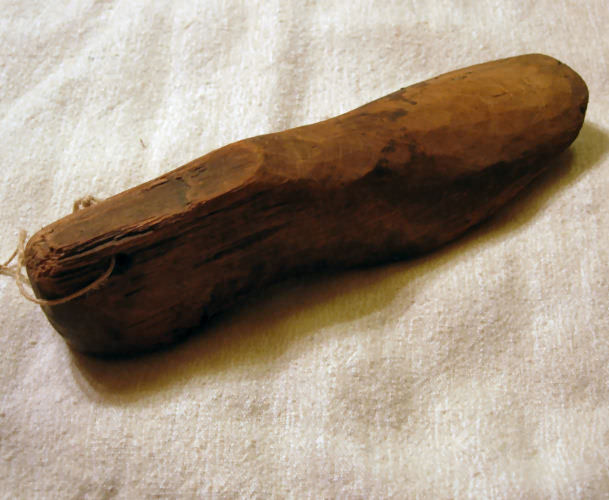

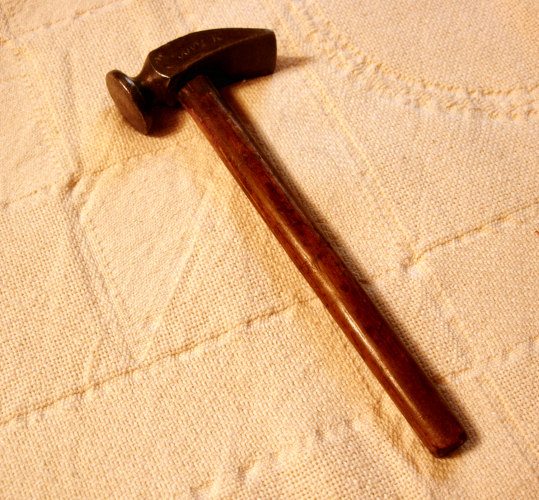
![]() My mother, Dollie's surname was Nofsker. She was descended from Michael and Anna (Servin) Naffzger. The Naffzger (variously, Neffzger) family originally made their home, during the mid-1600s, near Baden, in Canton Aargau, Switzerland (to the northwest of Zurich), but later came to reside in the village of Frauenfeld in Canton Thurgau, Switzerland (to the northeast of Zurich). Michael and Anna's son, Hans Caspar Neffzger, moved his wife Elizabeth (Gysi) and their family further westward, taking up residence in the village of Bubendorf in Canton Basel. It was at Burbendorf, that Hans Caspar Jr made a living as a shoemaker. His sons, Hans Caspar III and Hans Jakob, also took up the profession of shoemaker. A third son of Hans Caspar Jr, Heinrich, moved to the city of Basel, being listed in public records as a resident in both the Horburgstrasse and Colmarerstrasse sections of the city. Heinrich's grandson, Heinrich Naftzger, emigrated from his ancestral Swiss homeland with his maternal grandparents, Heinrich and Anna (Thommen) Meyer. The Meyers and grandson, Heinrich Naftzger, arrived at Philadelphia in the colonial province of Pennsylvania in 1771. Heinrich Naftzger was my mother's great-great-grandfather. After he married Margareth Beschtler in Lancaster, Pennsylvania, they moved northwestward to take up residence in Miles Township, Centre County, Pennsylvania. And guess what occupation Heinrich took up? He became a shoemaker! When he died, his will revealed a number of shoemaker tools. One of Heinrich's sons, Jonathan, would take up the profession of shoemaker, in turn, being listed as such after he moved to the Bedford County township of Greenfield circa 1838.
My mother, Dollie's surname was Nofsker. She was descended from Michael and Anna (Servin) Naffzger. The Naffzger (variously, Neffzger) family originally made their home, during the mid-1600s, near Baden, in Canton Aargau, Switzerland (to the northwest of Zurich), but later came to reside in the village of Frauenfeld in Canton Thurgau, Switzerland (to the northeast of Zurich). Michael and Anna's son, Hans Caspar Neffzger, moved his wife Elizabeth (Gysi) and their family further westward, taking up residence in the village of Bubendorf in Canton Basel. It was at Burbendorf, that Hans Caspar Jr made a living as a shoemaker. His sons, Hans Caspar III and Hans Jakob, also took up the profession of shoemaker. A third son of Hans Caspar Jr, Heinrich, moved to the city of Basel, being listed in public records as a resident in both the Horburgstrasse and Colmarerstrasse sections of the city. Heinrich's grandson, Heinrich Naftzger, emigrated from his ancestral Swiss homeland with his maternal grandparents, Heinrich and Anna (Thommen) Meyer. The Meyers and grandson, Heinrich Naftzger, arrived at Philadelphia in the colonial province of Pennsylvania in 1771. Heinrich Naftzger was my mother's great-great-grandfather. After he married Margareth Beschtler in Lancaster, Pennsylvania, they moved northwestward to take up residence in Miles Township, Centre County, Pennsylvania. And guess what occupation Heinrich took up? He became a shoemaker! When he died, his will revealed a number of shoemaker tools. One of Heinrich's sons, Jonathan, would take up the profession of shoemaker, in turn, being listed as such after he moved to the Bedford County township of Greenfield circa 1838.
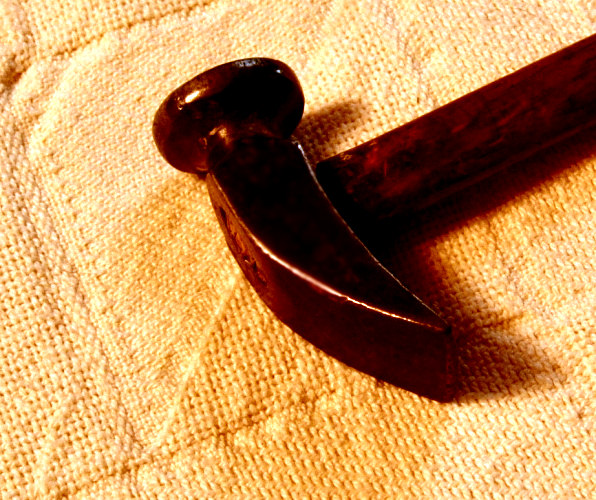
![]() Now, my primary intention in this post was not to give you a full family history of my mother's ancestors, but rather to point out that sometimes a profession or occupation is handed down from one generation to another. Such was the case with my Naffzger ancestors and the occupation of shoemaking.
Now, my primary intention in this post was not to give you a full family history of my mother's ancestors, but rather to point out that sometimes a profession or occupation is handed down from one generation to another. Such was the case with my Naffzger ancestors and the occupation of shoemaking.
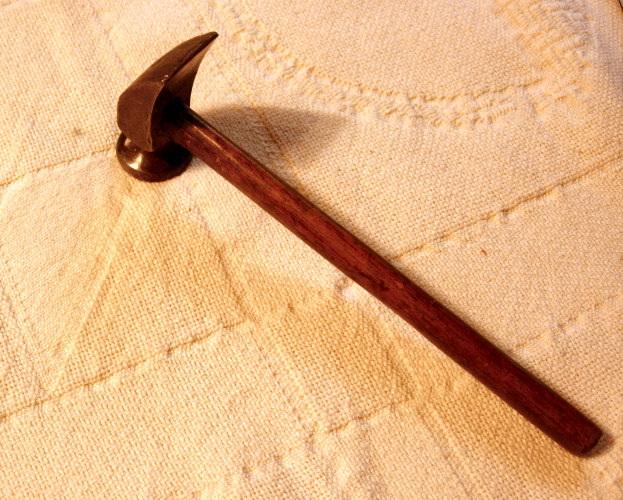
![]() Let's look at some names first. A shoemaker was once called a cordwainer. Cordwainers were identified in England as early as 1100. The name was gradually superseded by the name shoemaker as the need to differentiate between the shoe-maker and the shoe-seller became evident. Then there is the name cobbler. Many people think that the names cobbler and shoemaker were interchangeable. They weren't. The shoemaker, as the name suggests, made shoes. The cobbler, on the other hand, repaired shoes.
Let's look at some names first. A shoemaker was once called a cordwainer. Cordwainers were identified in England as early as 1100. The name was gradually superseded by the name shoemaker as the need to differentiate between the shoe-maker and the shoe-seller became evident. Then there is the name cobbler. Many people think that the names cobbler and shoemaker were interchangeable. They weren't. The shoemaker, as the name suggests, made shoes. The cobbler, on the other hand, repaired shoes.
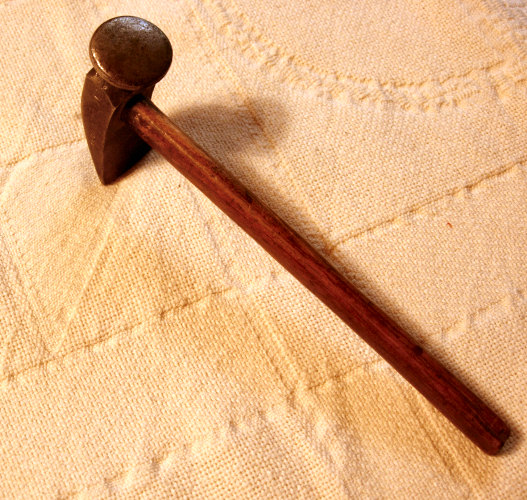
![]() The object pictured here is known variously as a shoemaker's hammer or as a cobbler's hammer. The same hammer would have been used to make and repair shoes, so the names are interchangeable. The shoemaker worked with very small tacks when constructing shoes, in the attachment of the heels to the soles, and so a small, but heavy headed hammer was ideal for his work. But other than that function, the hammer was not used for conventional hammering of nails in the making of shoes. Rather, the hammer was used to stretch and form the leather over a wooden or metal last. The wide, blunt end of the hammer was used to peen the leather, the word 'peen' meaning to form it into shape by striking it. The leather would often be dampened and then peened with the shoemaker's hammer; this resulted in the fibrous tissues of the leather being flattened, thereby making the leather somewhat water resistant.
The object pictured here is known variously as a shoemaker's hammer or as a cobbler's hammer. The same hammer would have been used to make and repair shoes, so the names are interchangeable. The shoemaker worked with very small tacks when constructing shoes, in the attachment of the heels to the soles, and so a small, but heavy headed hammer was ideal for his work. But other than that function, the hammer was not used for conventional hammering of nails in the making of shoes. Rather, the hammer was used to stretch and form the leather over a wooden or metal last. The wide, blunt end of the hammer was used to peen the leather, the word 'peen' meaning to form it into shape by striking it. The leather would often be dampened and then peened with the shoemaker's hammer; this resulted in the fibrous tissues of the leather being flattened, thereby making the leather somewhat water resistant.
![]() The leather was stretched and shaped over a wooden mold called a last.
The leather was stretched and shaped over a wooden mold called a last.
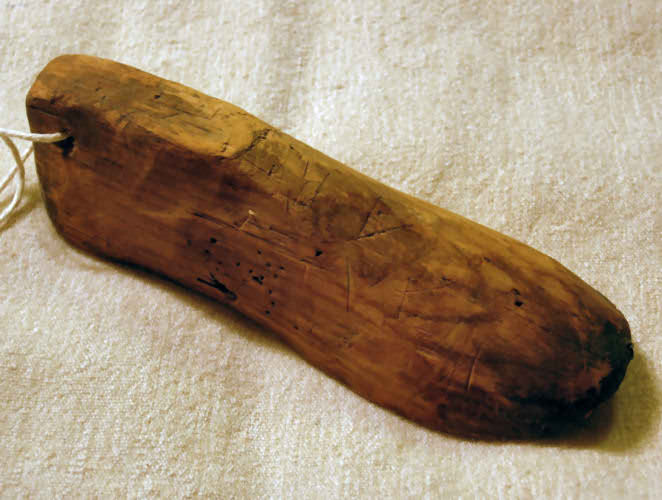
![]() The name for this mold was derived from the Old English laeste, which itself was derived from the Old High German leist, meaning a track or footprint.
The name for this mold was derived from the Old English laeste, which itself was derived from the Old High German leist, meaning a track or footprint.
![]() The shoemaker's last, as shown in the accompanying examples, was commonly made of wood, carved in the form of the inside of the intended shoe. The shoemaker would come to possess lasts in various sizes to accommodate a variety of customers' foot sizes. But only one last per size was needed because there was no difference between the left and right shoes.
The shoemaker's last, as shown in the accompanying examples, was commonly made of wood, carved in the form of the inside of the intended shoe. The shoemaker would come to possess lasts in various sizes to accommodate a variety of customers' foot sizes. But only one last per size was needed because there was no difference between the left and right shoes.
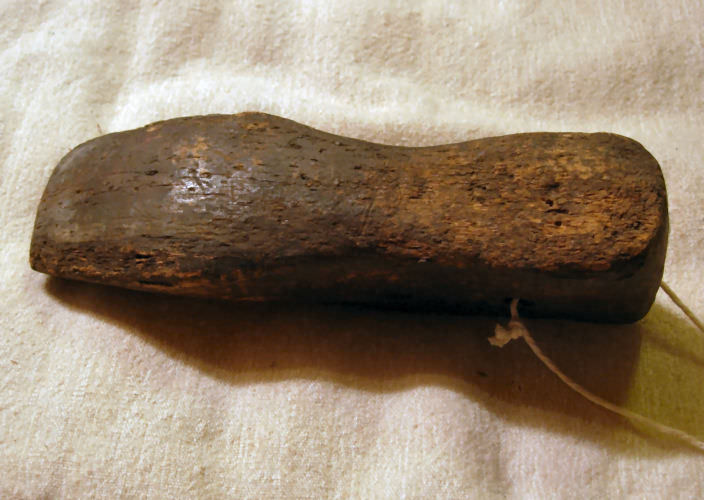
![]() Both shoes in a pair tended to be given square, flat toes; left and right were interchangeable. As the Nineteenth Century merged into the Twentieth, the wooden last came to be replaced by a metal one. Then, with the development of machines that accomplished all of the duties of the shoemaker during the Industrial Revolution, the shoemaker found himself out of a job.
Both shoes in a pair tended to be given square, flat toes; left and right were interchangeable. As the Nineteenth Century merged into the Twentieth, the wooden last came to be replaced by a metal one. Then, with the development of machines that accomplished all of the duties of the shoemaker during the Industrial Revolution, the shoemaker found himself out of a job.
![]() I acquired the wooden shoe lasts that are shown in this post at different times and at antique stores and flea markets throughout the south-central Pennsylvania region. The lasts which were used by Jonathan Nofsker, the most recent shoemaker in my mother's family, were found in a large trunk when his great-grandson was going through his deceased parents' estate. He called me up to ask if I had any idea why his parents would have a trunk full of a bunch of carved wooden 'things'.
I acquired the wooden shoe lasts that are shown in this post at different times and at antique stores and flea markets throughout the south-central Pennsylvania region. The lasts which were used by Jonathan Nofsker, the most recent shoemaker in my mother's family, were found in a large trunk when his great-grandson was going through his deceased parents' estate. He called me up to ask if I had any idea why his parents would have a trunk full of a bunch of carved wooden 'things'.
